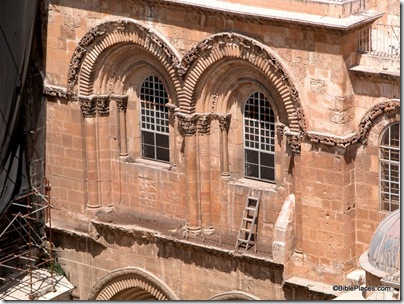If you’ve ever wondered what the background is for the fistfights, the unmoving ladder, or the eternal state of disrepair of the Church of the Holy Sepulcher in Jerusalem, this essay by Raymond Cohen at The Bible and Interpretation is well worth reading. Cohen goes back to the Crusader period to explain where the “Status Quo” came from and how it has evolved over the centuries. The following paragraphs may stir your interest, and if the article itself does not satisfy, you can pick up Cohen’s recent book, Saving the Holy Sepulchre: How Rival Christians Came Together to Rescue their Holiest Shrine (New York: Oxford University Press, 2008).
Out of communion for centuries, six ancient churches are represented today at the Holy Sepulchre by communities of monks. The three major communities administering the Holy Sepulchre, the Greek Orthodox, Roman Catholics—represented by the Franciscan Order—and Armenian Orthodox have their own chapels and share common areas, which include the stone of unction, the edicule containing Christ’s tomb, and surrounding paving. Two minor communities, the Coptic Orthodox and Syrian Orthodox, have rights of usage, but no say in the running of the church. The tiny Ethiopian Orthodox community, living on the roof, has no rights in the Anastasis….
In some respects, the Status Quo functions like a railway timetable, specifying for every day of the ecclesiastical year the time and place of services and processions conducted by the communities in public areas of the church. It also acts as a sort of property register, detailing possession of every stone and nail. Not a carpet can be laid, a candle lit, or a step swept unless it is the custom….
In the end, an inoffensive compromise design was agreed upon by church leaders and inaugurated in January 1997, enabling the scaffolding disfiguring the rotunda to come down. However, the restoration was unfinished: The edicule was left untouched, visibly disintegrating and only held together by steel bands; paving throughout the church was cracked and shabby; the electrical and sewage systems badly needed renovation, as did the malodorous public latrines….
You can read the whole thing here.

3 thoughts on “The Battles Within the Holy Sepulcher Church”
hese Christians see how they love one another!
“Not a carpet can be laid, a candle lit, or a step swept unless it is the custom.”
I can’t help but think of Jesus’ words to another group of legalists:
“Woe to you, scribes and Pharisees, hypocrites! For you pay tithe of mint and anise and cummin, and have neglected the weightier matters of the law: justice and mercy and faith. These you ought to have done, without leaving the others undone. Blind guides, who strain out a gnat and swallow a camel! …Woe to you, scribes and Pharisees, hypocrites! Because you build the tombs of the prophets and adorn the monuments of the righteous, and say, ‘If we had lived in the days of our fathers, we would not have been partakers with them in the blood of the prophets.’”
The older I get the more I appreciate tradition. But tradition cannot be preserved at the cost of unity and love for each other. The greatest command Jesus gave was to love each other, not to fight over the placement of a ladder or whether we should repair the latrines in our churches.
Unfortunately I believe Raymond Cohen has some misinformation in this bias opinion of the several churches in question regarding the Holy Sepulcher Church. In regards to who has what rights of use etc. As far as the fighting about *ownership*
I have this to say:
Is not the ownership the Holy Trinity? It is the house of the lord and to fight among themselves who *owns* it, is preventing the house of the Lord from receiving the due Repairs? If they are all Faithful to God the differences between them should be the last thing on their minds. And the benefit of the House of the LORD should be first.